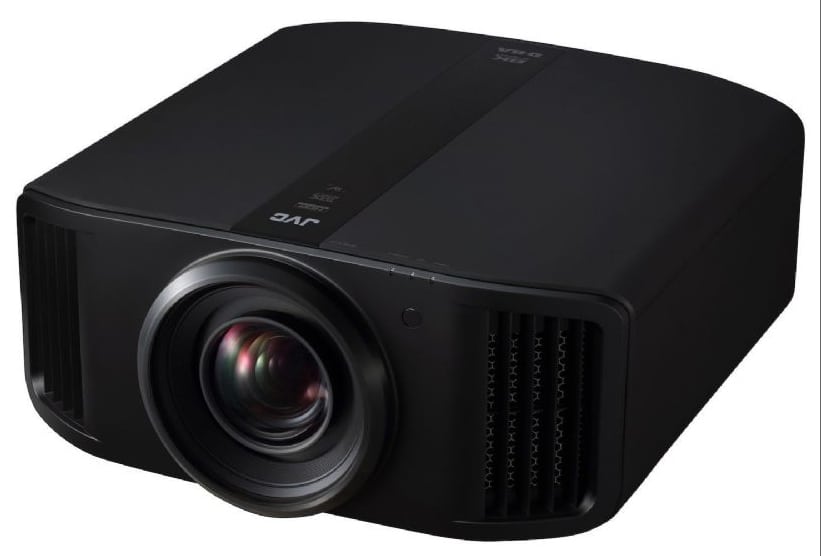Anticipation has been building recently as news spread that JVC would launch a new line of its popular home cinema projectors at the IFA event in Berlin.
Details released by UK distributor Invision reveal a totally new line up of three D-ILA projectors adopting the newest Native 4K D-ILA devices. Of particular note is the DLA-NX9, which promises to use the company’s e-shift technology to deliver the world’s first ‘8K’ home cinema projector.
This model is joined by two native 4K models, the DLA-N7 / N5, with all three due to be available in EMEA from late October.
With 4K still in its infancy, the 8K DLA-NX9 tech via e-shift technology, could be seen as a bit of a gimmick, however not having seen the product in demo as yet, lets reserve judgment on that one and perhaps focus on what looks like a solid set of up-grades all round.
The DLA-NX9 has a new100mm diameter high resolution glass lens, with the DLA-N7/N5 models offering the latest 4K D-ILA device and a 65mm diameter glass lens, all three feature a new 0.69in Native 4K D-ILA device.
Feature break-down
High definition video exceeding 4K realized by 8K e-shift technology (DLA-NX9)
e-shift is JVC’s proprietary high-resolution display technology that doubles the resolution by shifting pixels diagonally 0.5pixel. This e-shift technology together with the Native 4K D-ILA devices, enables the DLA-NX9 to produce an 8K image on the screen. Using original Multiple Pixel Control technology, JVC says it can perform this transformation on 4K and full HD images.
Newest 0.69 inch native 4K D-ILA device
JVC says the newest 0.69in native 4K D-ILA device with 3.8 ㎛ pixel pitch achieves high resolution display of 8.8 million pixels (4096 x 2160 pixels), and with an improved planarization technique which reduces light scattering and light diffraction results in both improved brightness and black level compared to conventional devices.
The narrow pitch is designed to provide Native 4K imagery with smooth, detailed picture without any visible pixel structure even on large screens.
High resolution 18-element, 16-group all-glass lens with full aluminium lens barrel (DLA-NX9)
The DLA-NX9 is equipped with a high resolution 18-element, 16-group all-glass lens with full aluminium lens barrel. To ensure high resolution up to every corner of the screen while realising a wide shift range of +/-100% vertical, +/-43% horizontal, a 100mm diameter lens was selected.
Not only that, five special low dispersion lens considering the different refractive index of Red, Green and Blue, have been adopted to suppress chromatic aberration, bleeding etc. and faithfully reproduce the 8K resolution.
New Auto Tone Mapping function automatically adjust settings for optimumHDR10 image
The HDR10 mastering information MaxCLL (Maximum Content Light Level) / MaxFALL (Maximum Frame Average Light Level) varies depending on the content.
Therefore, in order to achieve the best HDR10 experience it is necessary to set the appropriate brightness settings for each content. The new Auto Tone Mapping function automatically adjust settings based on the mastering information (in case of content that does not contain mastering information, it will be fixed value or manual adjustment).
Various HDR images with different brightness can be viewed optimally without manual adjustment of the settings.
Compatible with HDR
HDR content has more information than ever, such as expansion of luminance range, wide colour gamut such as BT2020, 10 bit gradation, etc. JVC says the new projectors faithfully reproduce HDR10 content in addition to the HLG (Hybrid Log Gamma) adopted in broadcasting etc., with its high brightness, high contrast, and wide colour gamut.
Bright, vibrant and dynamic imagery
A combination of 265W ultra-high pressure mercury lamp and efficient optical engine realize high brightness of 2,200lm (DLA-NX9). Together with the new D-ILA device which has a narrow pixel gap and improved light efficiency, smooth, powerful images are delivered says the maker. Brightness for DLA-N7 is 1,900 lm, for DLA-N5 is 1,800 lm.
Native Contrast Ratio of 100,000:1 translates to Dynamic Contrast Ratio of 1,000,000:1
The new 0.69in native 4K D-ILA device and optical engine with wire grid deliver native contrast ratio of 100,000:1 (DLA-NX9). In combination with Intelligent Lens Aperture which analyses the input image and automatically controls the black level, JVC says a dynamic contrast of 1,000,000:1 can be achieved. For DLA-N7 Native 80,000:1, Dynamic 800,000:1, for the DLA-N5 native 40,000:1, Dynamic 400,000:1.
Colourful image with wide colour gamut beyond DCI P3 (DLA-NX9, DLA-N7)
By adopting the new cinema filter, DLA-NX9 and DLA-N7 achieves a wide colour gamut beyond DCI-P3 as well as BT.709. HDR content such as UHD Blu-ray has adopted a wider colour gamut than before, and with a wide colour gamut D-ILA projector, it is possible to reproduce rich colours such as crimson rose and fresh green of trees, and the natural gradations of sky and sea, says JVC.
Renewed ‘Clear Motion Drive’ supporting 4K60P (4:4:4) signal
Clear Motion Drive is JVC’s original motion control technology which also supports 4K60P (4:4:4) signal. The feature has been renewed for the new line up improving moving images further. Together with Motion Enhance which optimises the driving of D-ILA device according to the motion of the image, motion blur is reduced.

Other features
- THX 4K DISPLAY (approval in progress) guarantees high-quality and high performance for the ultimate reference home theatre experience (DLA-NX9).
- ISF certification, not 100% clear as yet if this is in approval or delivered.
- Equipped with ‘installation mode’ function that remembers up to 10 kinds of installation adjustments such as lens memory, pixel adjustment, screen mask etc.
- Compatible with ‘Auto Calibration Function’ that optimises image quality under various installation conditions and also compensates for the changing colour balance in long-term projector usage.
- Screen Adjustment Mode corrects the colour balance that can differ by various screen characteristics.
- Low Latency Mode which decrease the input lags from the source.
- Optimised circuit configuration halves the time it takes for signal recognition compared to our conventional models.


